Contents
Watermelon loves sunlight and warm air. For maturation, he needs a lot of light, hot summers with rare but heavy rains, sandy soil. Nature created such ideal conditions in the Caucasus, in the Crimea, in the Astrakhan region, Primorsky Krai. But in the Urals and Siberia, you can also grow a juicy berry with scarlet sugar pulp, if you provide the right care for watermelons. In northern regions with cool summers, watermelons are grown in greenhouses. If you choose the right variety and take care of it, you can grow a watermelon in the country.
Greenhouse preparation
For growing watermelons, a greenhouse covered with any material (glass or polycarbonate) with a height of 1,6 to 2 meters is suitable. Since they must curl onto special devices, a lower height will prevent the lashes from developing and the fruit from ripening.
Greenhouse preparation should begin from mid-March. This is the time when you need to remove snow from it, check the entire structure, fix malfunctions, repair cracks and ventilate well. Before populating watermelons in a greenhouse, it is useful to sow radishes there, watermelons grow well on the ground where cruciferous used to be. After harvesting, it will just be time to plant watermelon seedlings in the ground.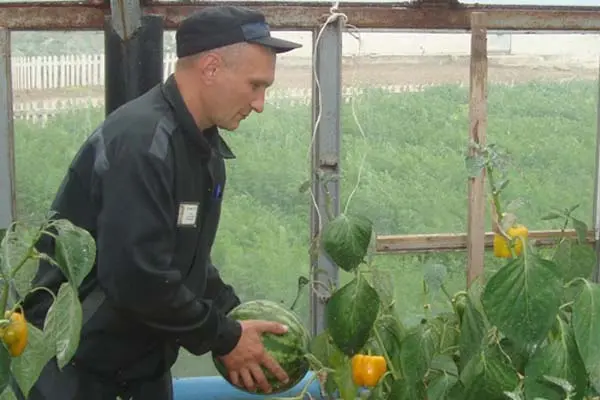
Watermelons grow well in sandy soil, so they will love this mixture:
- garden soil – 3 parts;
- humus – 3 parts;
- sand – 4-5 parts.
It is quite nutritious for the beginning of growth, then watermelons will still have to be fed with fertilizers.
Growing seedlings
Greenhouses usually grow varieties “Spark” (fruits no more than 2 kg, ripen in 70-85 days), “Pannonia” (ripens in 70-75 days), hybrid “Krisby F1” (fruit can grow up to 6 kg, ripens in 60-65 days). The early variety “Shuga baby” is very popular. It ripens in 75-85 days, the fruits, justifying the name, delight with sweet red granular pulp and grow up to 3-5 kg.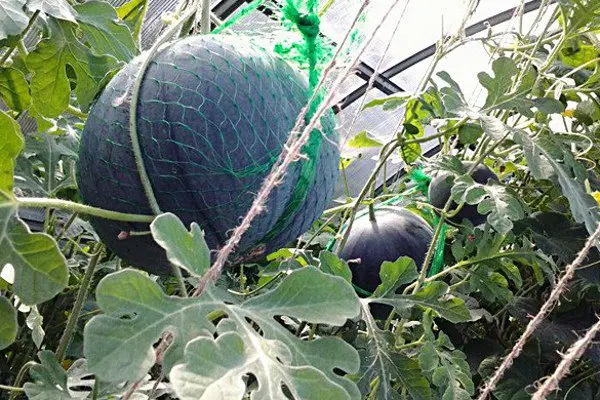
Experts advise not to get carried away with varieties with large fruits, small berries are better suited for greenhouses, they have a better ovary, and they are also easier to grow on trellises.
First, watermelon seeds are advised to warm up in the sun, and just before sowing, they are first poured with a weak solution of potassium permanganate, and then with warm (25 degrees) water.
Seeds are planted from the end of April. Seedlings will be ready for planting in 25-35 days. It is best to place the seeds in peat cups (with which they are then planted) with a diameter of 10 cm or separate plastic containers; when planting in the ground, the root system should not suffer. Fertilizers must be added to the soil mixture. These can be fertilizers with phosphorus, nitrogen and potassium, or you can add wood ash and potassium sulfate.
Some summer residents, when soaking seeds, use a growth stimulator or liquid diluted fertilizers for better germination. And others say that good seeds germinate well even without chemicals.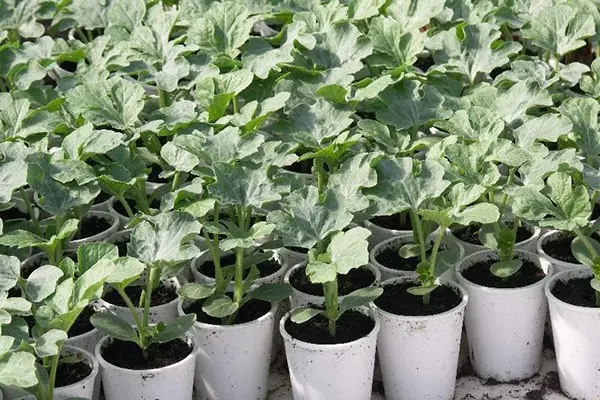
The seed should be deepened no more than 3 cm and placed on a barrel to make it easier for the leaf to come out of the shell. The optimum temperature before germination is 22-25 degrees, and for growing seedlings a little lower – 21-23.
Even before planting in the greenhouse, seedlings need to be fed, this is done 2 weeks after sowing with diluted mineral fertilizer. Previously, this cannot be done, because weak roots may not withstand contact with fertilizer. Young seedlings should receive full coverage for 10-12 hours; fluorescent lamps are suitable for this. With a lack of light, plants can stretch out too much and weaken.
Disembarkation
Planting seedlings on greenhouse beds should take place at a steady temperature of 20-25 degrees in mid-May. If the weather does not want to provide such weather, plants will have to be heated. The soil is prepared as follows: the top layer of soil is removed, the resulting trench is filled with humus and hay, all this is poured with plenty of hot water, and the excavated earth is laid on top.
Seedlings are planted directly in peat cups according to the scheme 70 cm by 50 cm (70 between rows, and 50 between plants), if it germinated in plastic cups, they are carefully cut so as not to damage the delicate root system. 2 sprouts can be planted in one hole, but carefully monitor and direct the whips in different directions. Watermelons do not like crowds and crushes, they will not bear fruit if the lashes are intertwined and interfere with each other. The hypocotyl knee should rise a couple of centimeters above the ground, otherwise it may rot.
The temperature should be no higher than 30 degrees, so on a hot day you will have to arrange ventilation. It must be remembered that the life of the male flower is short, if the greenhouse is closed and the bees bypass it, it is necessary to artificially pollinate the plants. When the fruits grow to the size of an apple, the lashes without ovaries are removed. One plant should have no more than 6-7 berries, after the last one you need to count 5 leaves and cut off the growth point.
Watermelon does not like a lot of moisture, so you need to be careful with watering, check the soil and water only after drying. A separate question, to which gardeners answer differently, concerns fertilizers. To grow a good watermelon to maturity, it needs to be fed. Usually, top dressing is done 3 times: when the lashes have grown stronger and grown to 30 cm, before flowering, when the ovaries have formed. It is no longer possible if we want to eat useful substances, not fertilizers.
But what to feed? Specialists recommend complex fertilizers, ammonium nitrate, superphosphates, ammonium sulfate, potassium salts. Supporters of naturalness prefer chicken manure (10 liter of manure is taken for 1 liters of water) and wood ash. No matter how you decide, no matter what you choose, you still need to fertilize. This should be done carefully, watering the plant at a distance of 20 cm from the stem for the first time and 40 cm in the future. Moisture, even water, should not fall on the stems and leaves at all, and you should always water with warm water.
Outdoor cultivation
If you have sandy loamy neutral alkaline soil in your country house and there is an open place warmed by the sun, then with proper care, early ripening varieties can ripen even without a greenhouse. In the southern regions of the country, in May-June, you can sow seeds directly into the ground to a depth of about 8 cm. 5-6 seeds are sown per meter of the plot, since they will not all sprout, it should not be too crowded. After sowing the seeds, they are watered with warm water. After a week, shoots should appear, and after the appearance of the fifth leaf, they are spudded.
In the middle lane, seedlings of early ripening varieties are planted on the site. Moreover, before planting on the site, it is hardened – the temperature in the room (if possible) is lowered to 16-17 degrees during the day, and at night to 13-14. If the temperature is not regulated, then you can simply take it out into the street.
Planted in holes with a size of at least 14 cm at a distance of 70 cm from each other and 1 m between rows. Planting should be such that the root collar remains 1-2 cm above the ground.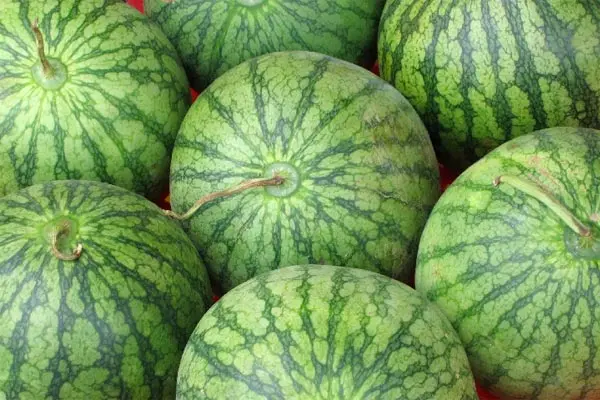
The Shuga baby variety ripens well in open ground, but it is better to grow it not from seeds, but from seedlings. Proper care of watermelon in the garden consists in rare abundant watering, obligatory loosening of the soil after watering or rain, and fertilizing. It is desirable to straighten the whips so that they do not interfere with each other, tear off the growth point after 6-7 ovaries. Plants need to be fertilized at the same frequency and in the same way as in a greenhouse. If the greenhouse fruits are tied up and they sing in the air, then in the garden the watermelon lies on the ground – you need to make sure that it does not rot, and even that the sun warms it from all sides.
Watermelons suffer from pests and diseases. Wireworms, ants, melon aphids, sprout flies, scoops – everyone wants to profit from watermelon. And there are diseases: powdery mildew, broomrape. From these misfortunes, plants are treated with chemicals (karbofos, phosphamide). Often, careful inspection and wood ash with laundry soap help to avoid trouble.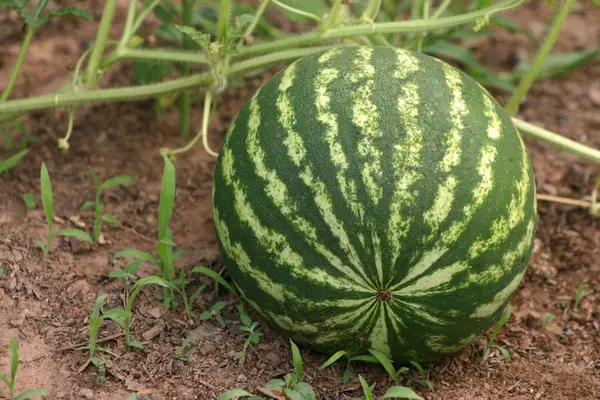
If you want to grow seedless watermelon, you will have to do it only in a greenhouse way. ‘Queen of Hearts’, ‘King of Hearts’, ‘Jack of Hearts’ mature in about 85 days, they like well-drained sandy-clay soils and plenty of sun. Their seeds germinate at a temperature not lower than 25 degrees.
Some amateur gardeners grow vegetables in barrels. Similarly, watermelon can be grown in an iron barrel. If you put fertilizer in a barrel and arrange a good drainage layer, and drill the bottom in several places, then you can try to plant a watermelon there. Since the soil in the iron barrel warms up well, he may like it. You just need to remember that the soil dries faster in the barrel, that it is not advisable to water the watermelon greens, and the fruits will have to be tied up, as in a greenhouse.
Video “Care for melons and watermelons”
Video lecture for gardeners, which tells about the cultivation of melons and watermelons. After watching the recording, you will learn how to plant seeds correctly, when to plant in the ground and how to fertilize.









